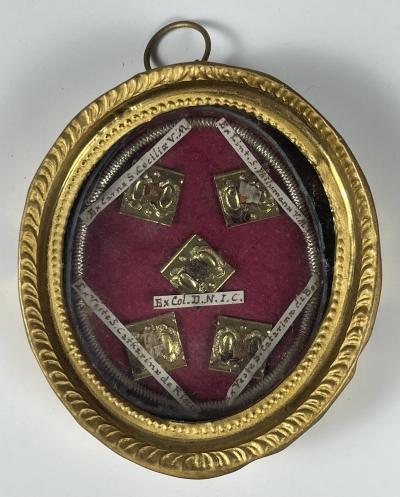Of the many relics associated with the Passion of Jesus, the Column of the Flagellation (or the Scourging Post) is one of the more physically imposing. Certainly, the significance of the Crown of Thorns, the Holy Lance, Holy Nails, pieces of the True Cross, and other first-class relics of the Passion cannot be understated. However, the sheer size of the Column of the Flagellation lends it a physical presence unmatched by other relics of the Passion. Saint Mark‘s gospel states, “So Pilate, wishing to satisfy the crowd, released for them Barabbas; and having scourged Jesus, he delivered him to be crucified.” The Column of the Flagellation is said to have been discovered by Saint Helena during a visit to Jerusalem in the 4th century and was eventually transported to Italy, and in the early 13th century to be installed in the Church of Saint Praxedes (Santa Prassede) in Rome by the appropriately named Cardinal Giovanni Colonna. Today, the Column of the Flagellation is kept in a small side chapel in the Church of Saint Praxedes, displayed in a glass reliquary.
Saint Cecilia (Latin: Sancta Caecilia) is the patroness of musicians. It is written that as the musicians played at her wedding she "sang in her heart to the Lord". She is one of seven women, excluding the Blessed Virgin, commemorated by name in the Canon of the Mass. Patron - Church music, great musicians, poets; Albi, France; Archdiocese of Omaha; Mar del Plata, Argentina.
Saint Philomena was a young consecrated virgin whose remains were discovered on May 24/25 1802 in the Catacomb of Priscilla. The remains were translated to Mugnano del Cardinale in 1805, becoming the focus of widespread devotion; several miracles were credited to the saint's intercession, including the healing of Venerable Pauline Jaricot in 1835. Saint John Vianney attributed to her intercession the extraordinary cures others attributed to him. In 1833, a Neapolitan nun reported that Philomena had appeared in a vision to her, and the Saint had revealed that she was a Greek princess, martyred at 13 years of age by Diocletian, who was Roman Emperor from 284 to 305. Saint Philomena is the Holy Patron of children, youth, babies, infants, priests, lost causes, sterility, virgins, Children of Mary, The Universal Living Rosary Association, Sibonga, and Cebu. Her feast day is venerated on the 11th of August.
Saint Catherine de' Ricci (†1590), was an Italian Dominican Tertiary sister venerated for her mystic visions and is honored as a saint by the Catholic Church. She is believed to have had miraculous visions and corporeal encounters with Jesus, both with the infant Jesus and with the adult Jesus. She is said to have spontaneously bled with the wounds of the crucified Christ. Her feast day is commemorated on February 2 and she is considered a patron saint of the sick.
Saint Catherine of Bologna [Caterina de' Vigri] (†1463) was an Italian Poor Clare, writer, teacher, mystic, artist, and saint. The patron saint of artists and against temptations, Catherine de' Vigri was venerated for nearly three centuries in her native Bologna before being formally canonized in 1712 by Pope Clement XI. Her feast day is 9 March.








 Поменять язык на русский
Поменять язык на русский 